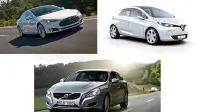Who should win 2013 World Green Car of the Year?

Those are the three finalists for the 2013 World Green Car of the Year award, and the winner will be announced later this week at the 2013 New York International Auto Show. The three finalists were named announced at the recent 2013 Geneva Motor Show. The annual award is limited to production vehicles that either are available to buy, or will be soon, on at least two of the world’s continents.
The 2013 Volvo V60 plug-in hybrid already is sold out for this production year, the Tesla S has been controversial lately for a dispute over its range ability, and the Renault Zoe is not available in North America. We wonder how the judges will take all this into account?
The 2012 World Green Car of the Year winner was the Mercedes S 250 CDI clean diesel, which beat out the other finalists, the Ford Focus Electric and the Peugeot 3008.
The world’s first diesel plug-in hybrid – the Volvo V60 Plug-in Hybrid – will make its American display debut and take centre stage at the New York International Auto Show. The plug-in hybrid is one of three remaining candidates for the prestigious 2013 World Green Car of the Year award.
The winning environmental car, which is selected by 66 top motoring journalists from 23 countries around the world, will be announced at the New York International Auto Show on 28 March.
The Volvo Car Group press conference in the Jacob Javits Center at 10:30 AM on 28 March will also include the world premiere of Volvo’s latest R-Design models as well as the announcement of a new and exciting addition to the North American Volvo model line-up.
The Volvo V60 Plug-in Hybrid in detail
The groundbreaking V60 Plug-in Hybrid is the world’s first diesel plug-in hybrid. It includes two complete drive trains and a powerful battery. The driver can select the preferred driving mode via three buttons that give the car three entirely different temperaments: Pure, Hybrid or Power.
“The ingenious on-demand possibility makes the V60 Plug-in Hybrid superior to all other hybrids on the market. Thanks to the Pure, Hybrid and Power modes, the car is the perfect choice for the uncompromising customer who wants to minimise his or her carbon dioxide emissions but maximise driving pleasure,” says Doug Speck, Senior Vice President, Marketing, Sales and Customer Service at Volvo Car Group.
- Pushing the Pure button gives the driver up to 50 kilometres (31 miles) on pure electric power.
- In Hybrid mode, the carbon dioxide emissions are 48 g/km. This corresponds to fuel consumption of just 1.8 l/100 km (NEDC certification driving cycle for hybrids), translating into 130 mpg.
- The Power mode releases the combined capacity of the diesel engine and electric motor, creating a veritable driving machine with a total power output of 215+70 horsepower and maximum torque of 440+200 Nm. The electric motor’s lightning-quick torque delivery contributes to the car’s acceleration from 0 to 100 km/h in 6.1 seconds.
Successful introduction
The outstanding properties of the Volvo V60 Plug-in Hybrid have been confirmed by several achievements since the car was introduced in 2012. The first year’s batch of model year 2013 cars was sold out even before the car reached the showrooms.
In 2012, the new Volvo V60 Plug-in Hybrid achieved the highest ever Euro NCAP score for an electrified car. The five stars in the test, which included a frontal offset collision at 64 km/h (40 mph), demonstrate that the V60 Plug-in Hybrid has the same high safety standards as a conventionally powered V60.
“Over 50 per cent of the Plug-in Hybrid buyers are conquests from competitor brands. The access to two drive trains and three driving modes makes it the perfect choice for consumers who want green motoring without compromises,” says Doug Speck. “The success of the plug-in hybrid is probably the most powerful signal of the revitalisation of the Volvo brand since we began our independent journey in 2010.”
The Volvo V60 Plug-in Hybrid is the synthesis of close cooperation between Volvo Car Group and Swedish electricity supplier Vattenfall. The two companies have financed the development project jointly.




